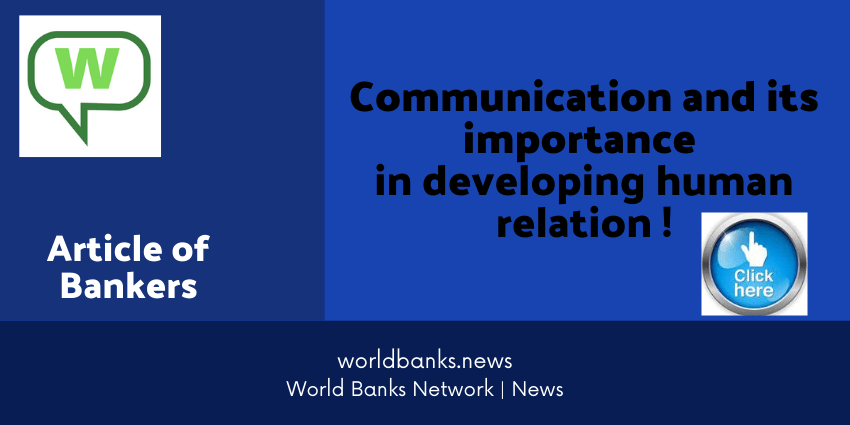Communication and its importance in developing human relation?
The Word “Communication” Originates from the latin word ‘COMMUNIS’ denoting ‘Common’, Communication, therefore, involves transmitting a Common idea or understanding and Covers any type of behaviour resulting in an exchange of meaning. Broadly communication is the process of meaningful interaction in between and among persons in an organization. It results in meanings being perceived and understanding effected among such persons. Thus Communication in human relation is the process of passing information and understanding from one person to another to achieve intended objectives.
Nature of Communication:
Communication may be in words, written or spoken. It also includes all means where by meaning can be conveyed from one individual to another. Even silence can amount to Communication. Gestures and facial expressions often communicate, even though the communicator is unaware of them. Mr. Elliott Jaques described communication as “the sum total of directly and indirectly, consciously and unconsciously transmitted feelings, attitudes, and wishes.:
Elements of Communication:
The basic elements involved in the process of communication are an information source, encoding, transmission, reception and decoding. The information source is a person who possesses knowledge or opinions which he desires to send to another person. so he expresses his ideas in some form (encoding) He may do this by speaking, writing etc. The transmission may be through face to face or hand written, typed words on paper or by physical movements etc that are seen or received by the receiving person. The receiver then decodes the message by gasping meaning and understanding from it. The communication is a two-way process. One person is communicating, the other is receiving the communication. The Communicator must therefore be conscious of the response of recipient. He must ascertain whether the recipient has understood him or not. The communicator must be aware of both sides of this communication equation. Taking the other side for granted is often the cause of miscommunication.
Types of Communication |
|||
| Type |
Description |
||
| Varbal | |||
| 1. | Personal | 1. | Face to face or over telephone etc. |
| 2. | Group | 2. | Face to face in a meeting. |
| 3. | Impersonal | 3. | Public address system, or video-tape, television etc. |
| Written | |||
| 1. | Personal | 1. | Letters, memos, reports. |
| 2. | Organisational (impersonal) | 2. | News letter, Posters, announcements circulars, computer output or other organisational publications. |
| Non-verbal | |||
| 1. | Body language | 1. | Hand signals, body and eye movements, facial expression pitch and tone of voice.
|
| 2. | Physical or symbolic | 2. | Signs, horns, sirens, badges, clothings and so on. |
Dimension of Communication:
In every organisation take place in three dimension generally, These are:
- Upward Communication.
- Downward Communication.
- Horizental Communication.
Sometimes there might be a direct Communication.
Essentials of Communication:
- Clarity of thought.
- Using of a suitable language
- Attaching importance to action rather than words.
- Using of appropriate media.
- Cordial MEN-BOSS relationship.
Barriers of Communication:
- Status relationship.
- Hearing what we expect to hear.
- Ignorance of informations.
- Evaluation the source.
- Words mean different things to different people.
- Jargon or Argot.
- Non verbal communication.
- Effects of emotion.
- Size of organisation
- Physical condition.
- Personal Animosity.
- Organisational Block.
- Faulty listening.
- Communication gap.
- Non-acceptability.
- Unfavourable environment.
- Effect of time & Wishes.
Effective Communication:
- Besure of what you wish to communicate and why.
- Be clear in the use of language. (If necessary give example)
- Watch how much you communicate.
- Use adequate medium.
- Provide appropriate climate
- Listen attentively
- Watch out for unintentional communications.
- Remember, communication is a two-way process.
- Be sure your action do not contradict your communication.
- Identify level, knowledge, age of communicatee.
- Creat atmosphere by appreciating communicatee-some times.
- Imparting communication training.
Importance of Communication:
Human relation is developed through adequate and effective communication. No organization can function without communication. It ties together the component parts of an organization and impel people to action. It is necessary to an organization as the blood stream is to a person. In other words, communication is like the ortery and viens in an animal organism which keep the flow of life blood pure and clear.
- Communication provides information, understanding and knowledge from person to person so that co-operative action can occur.
- It provides attitudes necessary for motivation, co-operation and job satisfaction.
- It establishes rapport that is complete and effective in promoting productive efficiency, organizational peace, prosperity and growth.
- It makes management aware of the nature and potentialities of the work force and help them to take action accordingly.
- Proper communication between groups reduce the points of friction and minimize problems that may arise.
- Communication plays a vital role at every stage of the control cycle beginning from the setting of objectives to comparison of the results with the norms.
- No collective action is possible in the absence of effective communication.
- Effective communication provides a key in the hands of the management to solve human relation problems.
- Improved in tra-management communication helps an organization go a long way towards welding together its management groups.
- It helps to mould attitude and impart beliefs in order to persuade, convince and influence behaviour.
- It helps for the entertainment and the maintenance of social relationship among human beings.
Seven Points on Effective Communication:
- Objectives should be explained before the executors/employees concerned before giving an order to perform a job.
- Hearing from the lower level may often be required before saying.
- Age, knowledge and level of understanding should be identified before saying.
- Signal or half information may save time and serve the purpose, but many times it may be the cause of failure.
- In case of lateral type of communication, misunderstanding may exist if the communicator and communicate do not have similar background of education, culture etc.
- Control and care may be necessary to communicate a thing to the over obedient subordinate employees.
Relationship between communicator and communicate is very vital. Attitude and retaining capacity of the communicate should carefully be judged before communicating a matter.




















